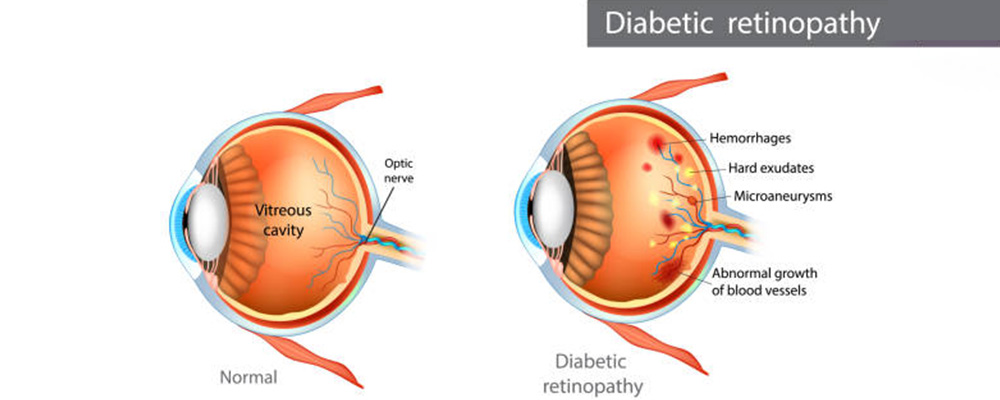
Does Low Vision Occur in Every Diabetic Patient?
There are a number of factors that accelerate retinal damage in diabetic patients; For example, smoking, pregnancy, anemia, co-existing kidney disease, high cholesterol, hypertension accelerate the damage caused by sugar to the eyes. 90% of patients with diabetes for 15-20 years have retinal disease. If blood sugar remains high for a long time, the eye vessels are affected and the nutrition of the nerve layer called the retina is impaired. New blood vessels form in the retina and fluid leaks out of these newly formed vessels. As a result of leakage in the vessels in the retina, fluid accumulates in the retina, causing the retina to swell. Since there is oily content along with the leaked fluid, these cause layers called exudate to form on the retina and reduce vision. If the diagnosis is made before new vessels form, there may be no change in vision during the period. However, this period progresses very quickly and can turn into dangerous forms in the future, causing a sudden decrease in vision.
How Does Diabetes Cause Blindness?
Diabetes affects the small vessels of the retina. As a result of damage to the vessels, fluid leakage occurs. This fluid leaking out of the vein causes edema in the visual center. Vision loss may occur as a result of bleeding into the eye. Bands form in the retina, which can pull on the retina, causing detachment and tears. Vision loss may occur due to malnutrition in the visual center.
Can Diabetes Be Controlled?
- Going for regular check-ups and monitoring patients without vision problems is the first step in treatment. Early diagnosis and timely treatment ensure satisfactory results.
- Good control of diabetes helps regulate hypertension, reduce fat levels in the blood, and seriously keep diabetes-related eye problems under control.
Tests Required for Follow-up and Treatment of Diabetes-Related Eye Disease
FFA-OCT FFA and OCT assays; It helps the physician in determining bleeding behind the eye, vascular bubbles (aneurysms) and leaks, staging the severity of the disease, and determining areas of insufficient blood supply in the back of the eye (ischemia). It is absolutely necessary in determining the necessary treatment and in follow-up.
In the FFA procedure, after a special dye (fluorescein) administered through the arm veins is introduced into the circulation system, photographs of the eye are taken for 10 minutes to investigate the presence of damaged capillaries. OCT method is taking very thin tomographic images of the eye nerve layer retina.
Treatment
The main treatment for retinopathy due to diabetes is laser application. Leaking bubbles are closed and the parts of the eye that cannot be nourished due to lack of blood are destroyed with laser beams. Although laser treatment does not restore lost vision, it significantly reduces vision loss within 2 years (by 50%).
The intraocular injection method we have been using in recent years has greatly increased our effectiveness in treatment.
Some patients may require surgical treatment for eye nerve layer tears and persistent bleeding.
Intraocular Injection Treatment
Diabetes and age-related macular degeneration are diseases that affect the retina layer. They are the most common cause of vision loss in older ages. The common cause of vision loss in these diseases is the development of new blood vessel formation in the retina layer containing the visual center. The newly formed veins due to these diseases cannot perform their duties ideally because they are not as strong as the existing original vascular structure. As a result, fluid leaks out of the vessels and bleeding occurs. Retinal edema develops as a result of the existing fluid leaking out of the vessel, that is, collecting in the retina, causing loss of vision. Treatment of developing loss of vision may be permanent, but if it is delayed, it becomes difficult to treat.
New blood vessel formation in the retina may cause blindness. There are some treatment methods to prevent this situation. The aim of treatments is to choose the most effective and least risky method first. Recent studies have shown the effectiveness of Injection Treatment in retinal diseases. Injection therapy is a method applied by injecting a drug that prevents new blood vessel formation into the intraocular fluid. Studies have shown that this drug has no toxic effect on the retina. The fact that it is a useful method for those with diabetes and age-related macular degeneration (macular degeneration) has enabled a wide range of patients to benefit from this treatment.
Create an Appointment Online
